The two main breathing (Pranayama) yoga practices are Kapalabhati and Anuloma Viloma or Nadi Shodhan (Alternate Nostril).
Yoga has two main breathing practises that you should do before you begin any basic Yoga Pose/Asana. This will help you to do any pose with ease.
Even though Surya Namaskar or Sun salutation is a complete body workout, it should be practised after you complete your Pranayama or breathing.
In this detailed article, I will explain on Steps of how to do Anulom Vilom or Nadi Shodhan (Pranayam), when and how many times to do each day, and what are its benefits, and the science behind it.
Introduction to Pranayama or Anuloma Viloma (Nadi Shodhan) Alternate Nostril Breathing
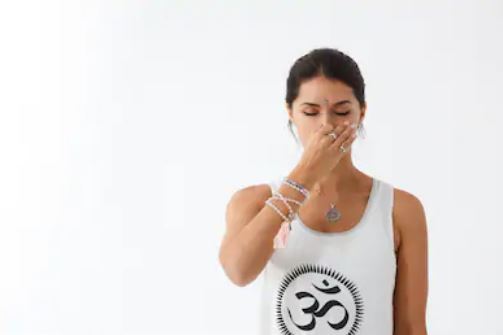
What is Nadi Shodhana Pranayama?
Nadi Shodhana Pranayama (is a practice of Hatha Yoga). It purifies the energy channels in the subtle body called nadis by breathing alternately through the nostrils. Here, Shodhana literally means “to purify.”
Nadi Shodhana is a practise to balance the prana or the vital energy through both left and right nostrils. Left nostril stands for Ida or the moon whereas, the right nostril stands for Pingala or sun.
Since this pranayama practice starts with left and also ends with the left nostril – it creates balance. It is because it balances the breath flowing through both the nostrils. Since it starts and ends with the left nostril that stands for the moon – it neutralizes the excess heat of the body.
What is the meaning of Anuloma Viloma Pranayama in Yoga?
Anuloma Viloma Pranayama or also known as Alternate Nostril Breathing practise is one of the main practices of Pranayama designed to calm the body and mind. It is a component of Hatha yoga practice.
The name comes from the Sanskrit word, ‘Anu’ meaning “with” and ‘vi’ meaning “against” and ‘loma’ meaning “hair”. Therefore, Anuloma means “with the hair” or “with the grain”, and Viloma means “against the natural course.”
Its purpose is to stimulate the nadis or energy channels that run throughout the body like electrical wires. Thus, the right side of the brain controls the left side of the body and vice versa.
Anuloma Viloma Pranayama attempts to cleanse the mind and stimulate the right and left nadis throughout the body. As a result, keeping a balance between the mind and body.
What is Nadi Shodhana
How to do Nadi Shodhana or Anuloma Viloma Pranayama (Alternate Nostril Breathing)?

Nadi Shodhana or Anuloma Viloma Pranayama(Alternate Nostril Breathing) is practised with a breathing sequence of 1:4:2 ratio. Breathe in for 4 counts, hold it for 16 counts and exhale for 8 counts.
For beginners, you can start with multiplications of 4. Always, remember the breathing starts with left nostril and also ends on the left nostril to complete one round.
Mentioned below are the steps on how to perform Nadi Shodhana or Anuloma Viloma Pranayama(Alternate Nostril Breathing) to exercise controlled breathing.
Step 1
To start Nadi Shodhan – begin by sitting in a cross-legged position, spine erect and shoulders relaxed. Close your eyes with your face straight ahead. For those of you who cannot sit cross-legged – sit on a straight-backed chair with your bare feet firmly on the floor.
Raise your right hand and mould your fingers into Vishnu Mudra by folding the index and middle finger under the base of the thumb. (In case you are a lefty – use your left hand).
Place your left hand in Chin Mudra on your left knee with palm facing upwards.
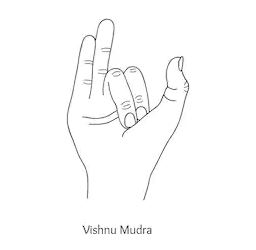
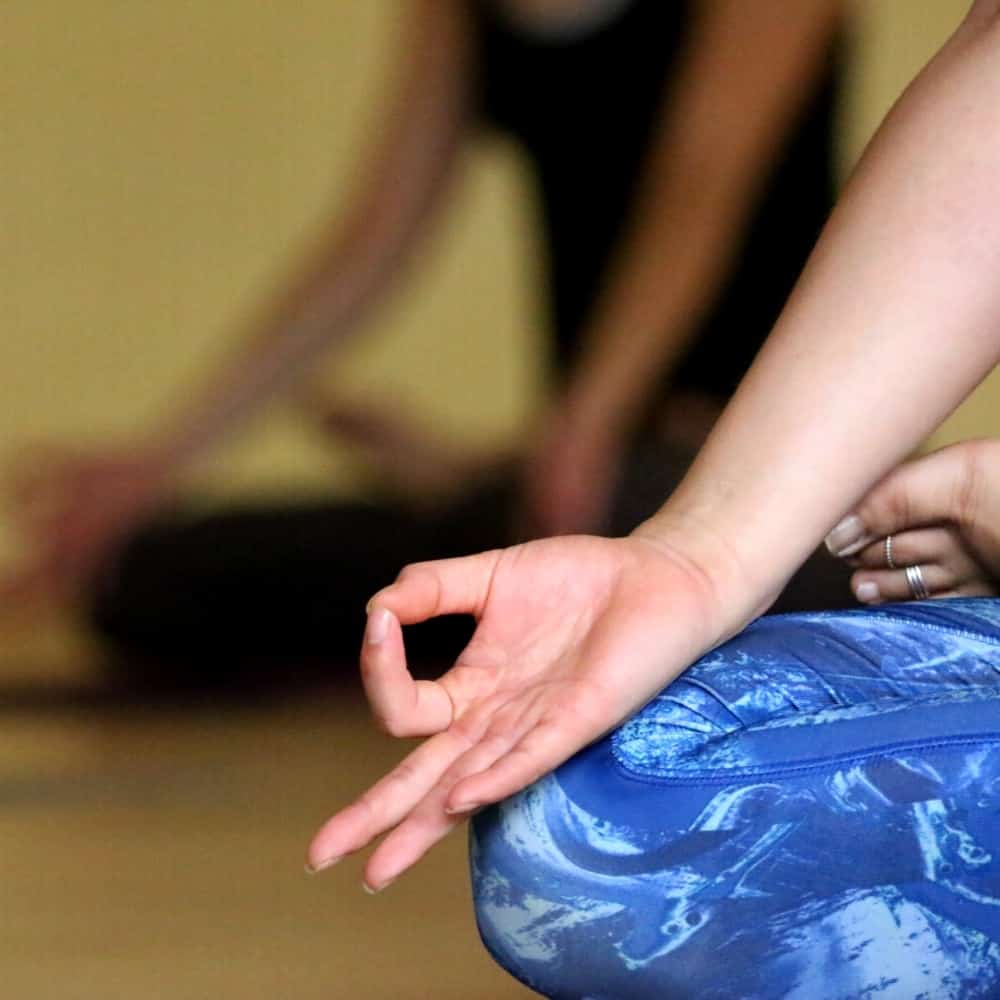
Step 2
Inhale completely through the left nostril for a count of 4, while keeping the right nostril closed by your thumb.
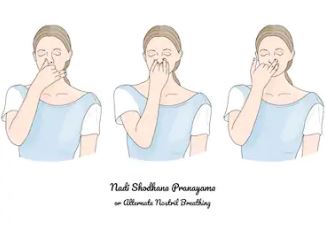
Step 3
Close the left nostril with the two ends of your ring and little fingers so that both the nostrils are closed. Hold this to the count of 16.
Tip: if you are a beginner and cannot hold your breath for 16 counts you could hold for 4 counts, to begin with, whatever is comfortable for you. Pranayama or Anuloma Viloma is about sending more and more oxygen to your brain – but it should not be under any kind of performance pressure. Practise Pranayama with ease and total comfort.
Step 4
Release the right nostril and exhale out to the count of 8.
Tip: Always exhale double than the counts you inhale. Try and exhale slowly and gradually to make it last got longer counts). If you cannot exhale for 8 counts as you begin – start with 4 for the first 1-2 weeks and then gradually go to 8 counts.
Step 5
Inhale fully through the right nostril to the count of 4.
Tip: Do not inhale forcibly – ever! Inhale without any sound as if you are breathing normally – only here you breathe through your abdomen to expand your lungs and fill them with as much oxygen as possible.
Step 6
Close both the nostrils and retain the breath to the count of 16.
Tip: If you are a beginner and cannot hold your breath for 16 counts you could hold for 4 or 8 counts, to begin with, whatever is comfortable to you. Pranayama or Anuloma Viloma is about sending more and more oxygen to your brain – but it should not be under any kind of performance pressure. Practise Pranayama with ease and total comfort.
Step 7
Release the left nostril and exhale out to the count of 8.
This completes one round of Anulom Vilom or Nadi Shodhan (Alternate Nostril Breathing) Pranayama.
How many rounds of Anulom Vilom (Pranayama) or Alternate Nostril Breathing to do in a day?
How many times to do Nadi Shodhan Anulom Vilom Pranayam each day:
If you are a beginner do at least 5 rounds and if it is more than a month since you have been practising Anuloma Viloma then, practise around 10 rounds in a day.
Once you feel comfortable with regular practice, you can increase the rounds and the count to the ratio of 1:4:2. This means for every second you inhale; you retain the breath 4 times as long and exhale for twice as long. Therefore, you must never change the ratio of the count.
Watch Video by Denzil Oconnell demonstrating Step by Step process to practise Nadi Shodhan Pranayama
What is the best time to practice Pranayama – Nadi Shodhana or Anuloma Viloma (Alternate Nostril Breathing)?
Best time to do Nadi Shodhana or Anuloma Viloma Pranayama:
Ideally, Nadi Shodhan Pranayama should be practised daily, in the morning before the sun comes up. It should be done before you start your yoga practice. It can help whenever you need to find a balance.
You can easily practice Nadi Shodhana or Anuloma Viloma (Alternate Nostril Breathing) while at home, seated at your desk, travelling, or any time you need to find balance.
Can I do Nadi Shodhan or Anuloma Pranayama after a meal?
Anuloma Viloma or Nadi Shodan before or after meals:
You can practice this Yoga Pose at any time of the day, however, it is best to perform in the morning with an empty stomach.
If you are doing this pose in the evening, then, make sure you do not eat for at least 3-4 hours before that. You can perform this asana for 3-4 minutes in the morning and 3-4 minutes in the evening.
The benefit of Anulom Vilom is best reaped when practised on an empty stomach or with a gap of 3 to 4 hours after having a meal.
Always do this Pranayama before you start any Yoga Pose – to calm your mind and body and regulate your breath.
Can we do Anuloma Viloma – before sleeping?
Nadi Shodhan or Alternate Nostril Breathing and Sleeping:
Pranayama helps in better oxygen intake, increasing the flow of oxygen in your bloodstream. Thus, helping your body to relax and preparing it to sleep better.
Nadi Shodhan or Alternate Nostril Breathing (Anuloma Viloma) is primarily a balancing Pranayama and Nadi purifying. It works virtually on every organ and dislodges the toxins from the body.
Benefits of Pranayama – Anulom Vilom or Nadi Shodhan (Alternate Nostril Breathing)
Physical Benefits:
- Nadi Shodhan helps to cure mental problems like depression, anxiety, stress, tension.
- Most beneficial for breathing-related problems like bronchitis, asthma.
- It strengthens, improves and cleanses the lungs and respiratory system.
- Boosts your memory and makes your brain sharper.
- Improves your immune system, therefore able to cure issues like a cough, cold and fever.
- Keeps blood pressure in control.
- Oxygenates the blood and keeps the heart pumping.
- Calms and balances the nervous system.
- It relieves headaches and migraines.
- Cures illnesses connected to the muscular system such as arthritis, flatulence varicose veins, acidity, and sinusitis.
- It controls obesity and streamlines metabolism.
- Provides aid in conditions such as constipation, acidity, allergic problems, asthma, diabetes, gastric problems and snoring.
- Eliminates drowsiness.
- It relieves eye and ear issues.
Mental Benefits:
- Thoughts become more positive and you learn to overcome stress, tension, anger, forgetfulness, anxiety, uneasiness, and lack of sleep.
- Increase in concentration levels, decision-making ability, and creativity and helps you to be more patient.
- Anulom Vilom helps to calm the mind and make you feel relaxed and peaceful.
- It stores and controls Prana, the vital energy present in our body.
- The alternate nostril breathing Pranayama balances the psychic system.
Step by Step – Sun Salutation Pose and Benefits
Common Mistakes:
- The use of fingers is wrong.
- Back is not straight and the head is in a drooping position.
- The chest drops while exhalation.
- The breath is not smooth.
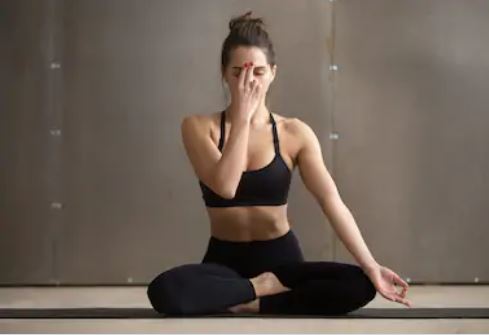
Nadi Shodhan contraindications or Anuloma Viloma?
Who should not do Alternate Nose Breathing:
- If you suffer from a blocked nose, do not do the retention. Instead, inhale to the count of 4 and exhale through the alternate nostril for 8 counts. Repeat the same for the alternate nostril.
- If you are suffering from heart ailments, you should not attempt retention of breath.
- If you also suffer from high blood pressure, avoid retention of breath.
The science behind – Anuloma Viloma or Nadi shodhanA
Anuloma Viloma (Nadi Shidhan) Pranayama is not just a form of breathing pattern, but, there is an inherent science behind it.
Scientists have discovered through numerous research that the nasal cycle correlates with your brain function. They found the electrical activity of the brain to be greater on the side that is opposite to the less congested nostril.
As a result, the right side of the brain controls your creative activities, while the left side controls your logical verbal activities.
Scientists used this experiment on their test objects with relevance to both sides of the nostrils and what effect it had on the brain. The results depicted that, when the left nostril was less clogged, the right side of the brain was more in control. The test subjects were indeed found to do better on creative tests.
Similarly, when the right nostril was less obstructed, the left side of the brain was dominant in nature. Thus, the test subjects did better on verbal skills.
Anuloma Viloma or Nadi Shodhan (Alternate Nostril Breathing) does not only work wonders on the brain but purifies the different channels of the body. It makes it healthy, strong and lustrous.
3 Yoga Breathing Pranayama poses for Air Pollution
COnclusion
Anuloma Viloma or Nadi Shodhan (Alternate Nostril Breathing) ) is more than breathing practise. It revitalizes your body internally and externally.
I am sure you must be wondering how can a simple breathing exercise have such an impact on your body?
Well, that is the magic of yoga!
It will generate an inner strength that will help you to overcome any uncomfortable experience or challenge.
Practice this pose regularly, and you will bask in the therapeutic and positive benefits and lead happier lives.
Related Articles:
8 Ways to Attract Good Energy in your Life Everyday
How to do Kapalbhati (Skull Shining Pranayama)
Best time to eat Breakfast Lunch and Dinner as per Ayurveda
Pranayama – Part 1 Video by Denzil Oconnell to strengthen Immune System
3 Yoga Breathing Exercises for Air Pollution
Affirmations: Forgiving Yourself to heal Your Soul
How to Speak Truth with Mindfulness



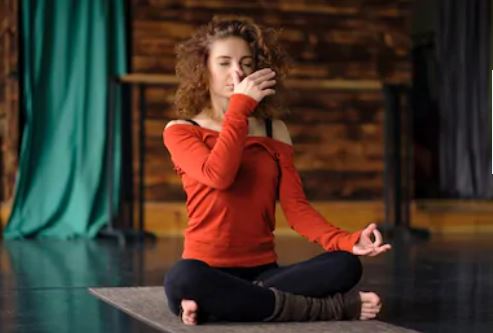

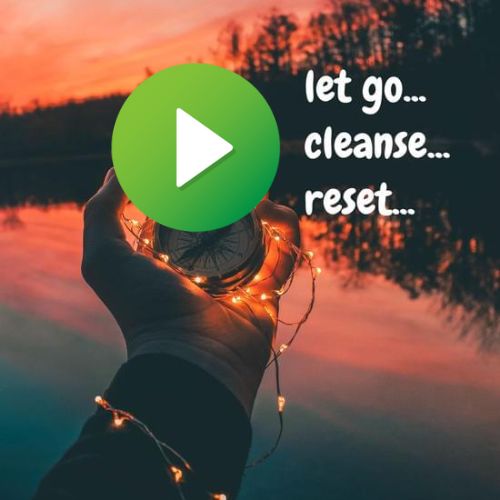
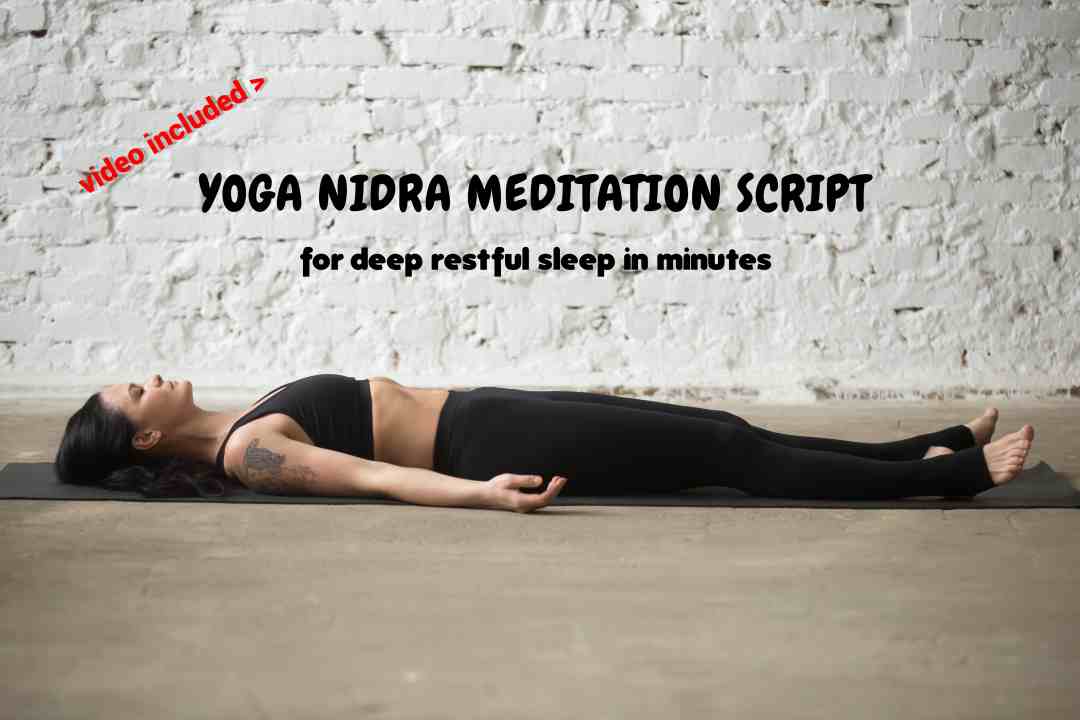



One Response